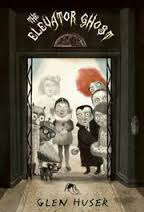The Elevator Ghost – About The Book
 Books | About the Book | Synopsis | Questions & Activities
Books | About the Book | Synopsis | Questions & Activities
An elementary school teacher and teacher-librarian for most of my working life, I have always loved the special days that dot the months of a school year. In October, of course, I scoured bookshelves for stories and novels to read aloud as we headed into Halloween. Joanna and Paul Galdone’s The Tailypo: A Ghost Story and Molly Bang’s Wiley and the Hairy Man were favourites—maybe because they were scary but not too scary, and both had that appealing colloquial language that conjures up a feeling of tales told around a campfire at night. In the bibliography at the end of the teachers’ guide guide, I’ve included these along with a number of other favourites.
Why do people enjoy hearing scary stories? They have been told since ancient times and remain popular today. Many fairy tales have scary elements in them. Monsters, ghosts and villains abound in children literature and in movies intended for child audiences. It is possible for words and images to give us the kind of thrill that we crave for entertainment (a mental roller coaster ride?). From the security of an armchair, a seat beside a campfire, or a cushion in a classroom or library story corner, it can be wonderful to wander through the dangerous territories of story.
But with young children we need to be aware that there is a fine line between stories that provide an enjoyable roller-coaster ride and those that end up giving a child nightmares. One of the ways to make a scary story palatable for a younger audience is to tell it with humour and, of course, to allow the hero of the tale to emerge triumphant or at least unscarred. In The Elevator Ghost, I decided to include the narrator of the stories as a major character—making her a figure with whom children would be comfortable.
I would encourage you to read The Elevator Ghost aloud as you work with the book. The stories throughout invite a reader to play with voice variation. Scary stories often build in tone, beginning quietly, conversationally and gradually escalate in pace and volume. Stepping into Carolina Giddle’s sequined sneakers, you will have a chance to be a fierce skeleton hollering to get his missing bones back; wolves howling in the dark; a beaky, bat-winged movie monster croaking and cawing as it scrambles to life; rowdy pirates hurling threats at one another; and a ghostly extraterrestrial sobbing after a spaceship crash. A little nervous about doing these yourself? You might want to coach a few student “sound effect specialists” to step in at the right moments.
Have fun!
